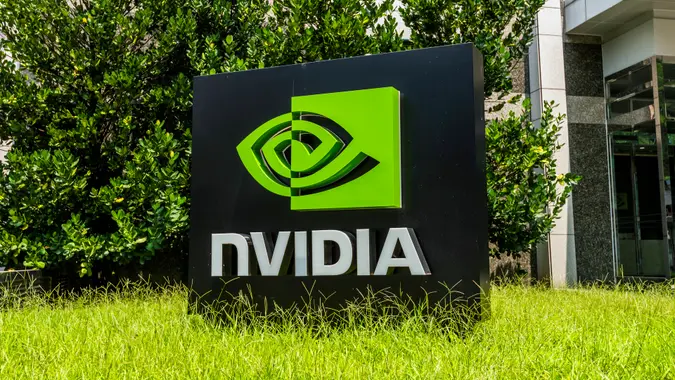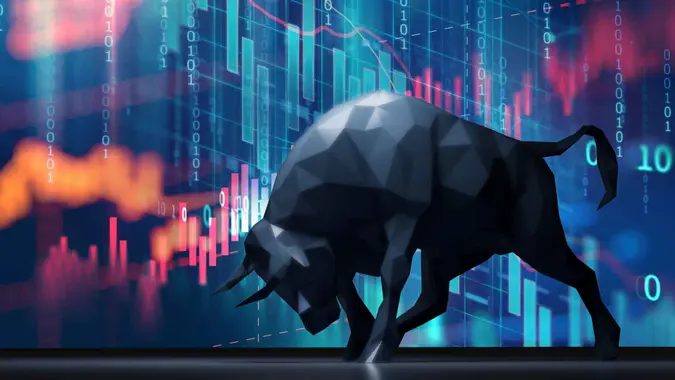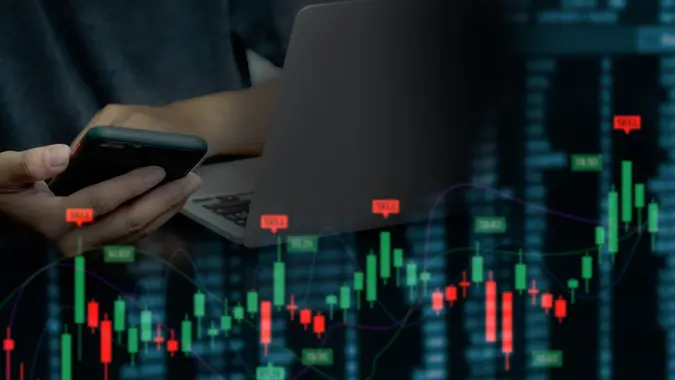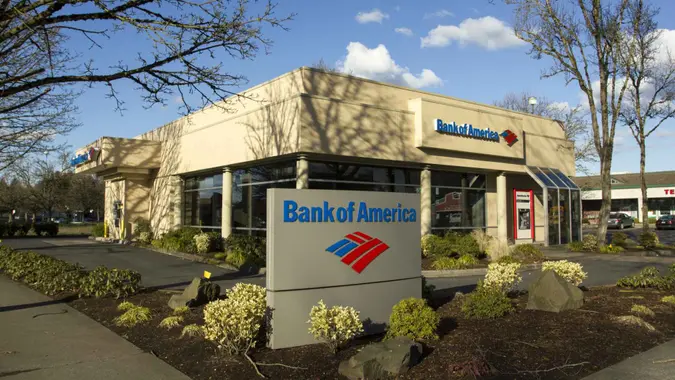7 Best Ways To Start Investing With Little Money

Commitment to Our Readers
GOBankingRates' editorial team is committed to bringing you unbiased reviews and information. We use data-driven methodologies to evaluate financial products and services - our reviews and ratings are not influenced by advertisers. You can read more about our editorial guidelines and our products and services review methodology.

20 Years
Helping You Live Richer

Reviewed
by Experts

Trusted by
Millions of Readers
Contrary to popular belief, you don’t need thousands of dollars to start investing right away. You don’t even need hundreds if you can figure out the right strategy for yourself and create a plan to start investing.
In this digital age, anyone can participate in the stock market and buy assets ranging from exchange-traded funds to cryptocurrency with just a click of a button. Thus there are many ways to start investing with little money.
How To Get Started With Investing
If you’re investing for the short-term or are looking to be more conservative with your investments, it is best to use safer investment and savings vehicles. Investing with a short timeline means you might need your money soon. The market can be unpredictable and volatile — you might have to sell all your holdings during a downturn, amounting to major monetary losses.
Maintaining some amount of savings typically allows you to follow a more flexible, long-term investing plan and will make you feel more comfortable investing in a market that can go in either direction.
If you don’t feel secure investing your money just yet, you can save up through a traditional cookie jar approach by putting away $1 to $10 each day. This can be done with an actual physical jar you have lying around if that sounds fun, or with an online savings account.
There are other safe options that will still grow your money while allowing you to save — more liquid investment and savings vehicles, such as high-yield savings accounts. These not only offer you a higher return than your regular bank savings account but also leave your money accessible in the short term.
On the other hand, if you have a longer timeline and are ready to start investing now, there are many ways to begin with less than $500. If you’ve been wondering how to start investing with little money, here are the seven best strategies:
1. Buy Fractional Shares of Stocks and ETFs
Fractional shares have been popularized by the Robinhood mobile app in recent years. They allow investors to buy into companies where one share may typically be too expensive. For example, it currently costs over $1,500 to buy a single share of Chipotle Mexican Grill (CMG), but 0.1 share of Chipotle is only $150.
Purchasing fractional shares has been simplified by apps like Robinhood and brokerages like Fidelity. You can start investing in fractional shares of individual stock on either platform for as little as one dollar. Some brokerages may not fully support fractional buying of any individual stock on the market, but many offer fractional purchases of a selection of ETFs or stock from certain indices.
In the past, buying stocks at such a low initial investment would not be ideal, given that brokerages charged a few dollars in commission for every stock transaction. Imagine paying $2 for every $1 stock purchase you made! Happily, this is no longer the case — commission-free trades have been widely popularized, compelling even the most mature brokerages like E-TRADE and Charles Schwab to adopt a zero-commission policy.
Accordingly, buying a small number of fractional shares per transaction is now a very cost-effective way to start investing in your favorite high-priced stocks and ETFs for as small of an initial investment as you want.
2. Invest Your Spare Change
If you only want to invest small amounts and would love to do so automatically with the spare change you won’t miss, there’s an app for that.
Two of the most popular mobile apps for investing your spare change are Acorns and Stash. They round up purchases you make with your credit or debit cards to the nearest dollar and then automatically invest that amount for you — in the case of Stash, once your savings total $5 or more. For example, if you bought groceries for $40.50, the app would round up the purchase to $41, investing the additional $0.50.
Where the money gets invested depends on your portfolio preference. When you onboard with the app, you’ll get to choose what your portfolio looks like, and you can rebalance at any time. If you’d like to have 55% large-cap stocks and only 5% small-cap stocks, you can select a preset portfolio type that matches your preferences. Your money will automatically distribute accordingly.
This makes for a great diversification of assets, automating what could otherwise be a stressful and tedious process. However, the one thing you need to keep in mind with these apps is the fee. Acorns is $3 per month, and Stash is $1 per month. This could be a large percentage of your portfolio if you’re not depositing much every month.
3. Dollar-Cost Average Into Low-Cost ETFs or Mutual Funds
The dollar-cost averaging strategy is popular among investors who’d rather not invest a large lump sum only to immediately lose money due to a downturn in their investment.
To dollar-cost average assets, simply adapt the cookie jar savings approach to investing. That is, deposit a small amount of money at regular intervals to ensure that the cost of your purchase averages out over time. Some of your money will invest in peaks and some in dips, so your cost will end up being the average.
If you don’t have enough money to buy one share of pricey individual funds or stocks at a time, there are a lot of cheaper ETFs and low-minimum mutual funds available. While there are great lists found on investment websites and plenty to browse on Vanguard, here are some diverse ones to look into that could get you started:
- iShares S&P Mid-Cap 400 Growth ETF: IJK, $70.33
- Schwab Small Cap Index: SWSSX, $29.78
- Schwab US Dividend Equity: SCHD, $73.65
- Vanguard Total International Stock: VXUS, $52.75
- Vanguard Total Stock Market ETF: VTI, $202.28
- Vanguard Total World Stock Index Fund ETF: VT, $89.73
4. Invest in Stablecoins on a High-Interest Rate Platform
You may be aware of high-yield savings accounts, where interest rates on your savings could be 10 to 20 times that of your regular bank savings account. That sounds great, but it’s nowhere near what any of the current popular cryptocurrency platforms will give you for your dollar. High-yield savings interest rates are far outclassed by investing in stablecoin on a trading and lending platform like Blockfi or the Celsius Network.
What Is Stablecoin?
You’ve likely heard of popular and widespread cryptocurrencies like bitcoin and ethereum. However, fewer people have heard of stablecoins. These are cryptocurrencies pegged to an asset such as the U.S. dollar. Some of the most popular stablecoins are USDT, USDC, and GUSD, which are from Tether, Coinbase and Gemini.
These stablecoins purport to be backed by the U.S. dollar primarily, and perhaps other assets, like short-term debt instruments, so each coin is backed by cash or other assets held in reserve. As such, stablecoins are thought to be safer because they can be converted back to a dollar at any time. However, there’s no guarantee. The stablecoin tether, for example, recently “depegged,” dropping to as low as $0.29. But typically, stablecoins only experience small fluctuations of one or two cents at times due to changes in liquidity or supply and demand.
By keeping stablecoin on trading and lending platform like Blockfi, you can earn high interest while investing with relatively little money.
These platforms can afford to pay out such high interest due to their lending rates. They lend out cryptocurrency that users keep on their platform with very high interest rates for the lender, allowing them to then pay out a portion of that interest.
As with all cryptocurrency trading, keeping your money as stablecoin on these platforms should be thought of as investing, not as an high-yield savings. Keep in mind that you are still converting your dollars to a form of cryptocurrency — that money can be lost if something goes wrong.
Blockfi
- PAX Interest Rate: 7.5%
- GUSD Interest Rate: 7.5%
- USDC Interest Rate: 7.5%
Celsius Network
- USDT Interest Rate: 15.9%
- GUSD Interest Rate: 2.55%
- PAX Interest Rate: 0.95%
Nexo
- USDT Interest Rate: 12%
- DAI Interest Rate: 12%
- USDC Interest Rate: 12%
Youhodler
- USDT Interest Rate: 10.7%
- DAI Interest Rate: 10.3%
- USDC Interest Rate: 10.3%
Binance.us
- SOL Interest Rate: 4.50%
5. Lend Your Money for High Interest With Peer-To-Peer Lending
In the same vein as the cryptocurrency lending platforms, there are peer-to-peer lending platforms where you can lend your money directly to individuals. This is profitable for lenders and convenient for borrowers who would otherwise have to go through a long process at a financial institution and potentially have their loan denied.
Currently, one of the most popular P2P lending platforms for lending fiat money is Prosper. Meanwhile, a rising star in the cryptocurrency realm is KuCoin. Prosper’s average historical return is 5.7%. It carries less risk than KuCoin, and a greater degree of investing can be automated in its platform. KuCoin’s annualized rate for USDT ranges from $1.46% to 730% on short-term loans of seven to 28 days.
P2P lending’s high returns come with greater risks, whether from potential hacking attempts or the immaturity of a fairly new company and sector. When a borrower defaults on a loan, there is also a chance that the borrower’s collateral not be enough to cover the full amount loaned. Make sure you’re comfortable with this risk-reward ratio.
6. Own a Piece of Real Estate Through REITs and Crowdfunding
Given that owning real estate has a high barrier to entry, real estate investment trusts and real estate crowdfunding platforms serve as a way to invest in the real estate market with relatively little money.
A REIT is a company that owns or finances different types of property. You invest in a REIT in the same way you invest in a stock or ETF — by buying shares of the company. You then earn a portion of the profits from rising prices and rental income of the REIT’s investments, in the form of high dividend yields and regular investment return.
Real estate crowdfunding platforms operate similarly. Everyone chips in to invest in a full piece of physical real estate. However, using crowdfunding will typically be riskier than a REIT since your investment is limited to specific pieces of real estate. This is similar to buying an individual stock.
To get started, check out these popular real estate crowdfunding platforms, all of which have minimums of $500 or less:
- Fundrise: $10
- Diversyfund: $500
- Groundfloor: $10
Takeaway
Investing in real estate through these means is much simpler than the traditional method. There is no need to obtain a loan to purchase the property or to pay for its maintenance.
7. Invest in Your Own Business
Do you have an entrepreneurial mindset? Are you interested in building your own brand? Consider simply investing a little money in your own business. Whether it’s walking dogs or your own freelance company, a small investment is a great start. You could put $100 toward fliers and supplies or a website and domain to advertise your business on.
A small investment in something you enjoy and would like to turn into a business can go a long way. Even if it’s just a little at first, the money will build on itself like a stock investment and compound. As you earn revenue, deposit a portion of that profit back into the business to continue growing it and gaining customers or clients.
No matter how you choose to invest or the amount of your investment, carefully plan a strategy that best suits your lifestyle and long-term goals. Invest early if you can. Remember, cash is always at risk of devaluing due to inflation.
More From GOBankingRates
- The Best $20 You Can Spend at Dollar Tree, According to Superfans
- 10 Cars That Outlast the Average Vehicle
- This is One of the Best Ways to Boost Your Retirement Savings in 2024
- 7 Things You'll Be Happy You Downgraded in Retirement
Daria Uhlig contributed to the reporting for this article.
 Written by
Written by  Edited by
Edited by 
























